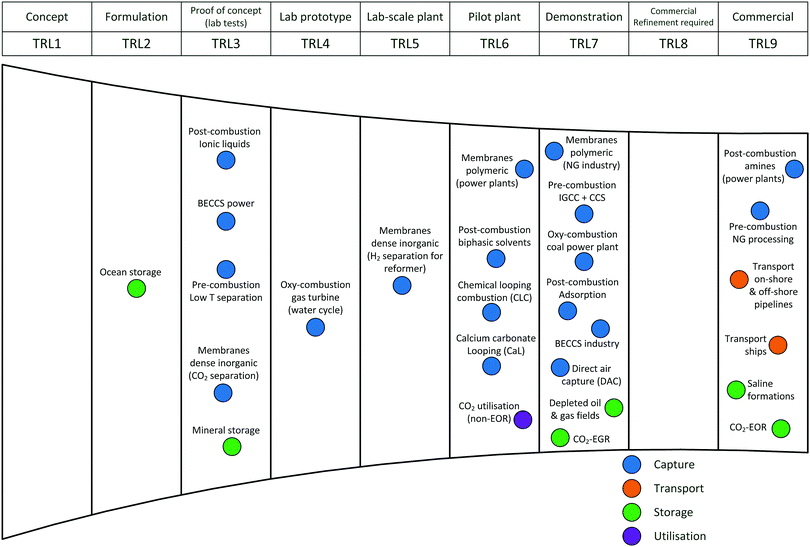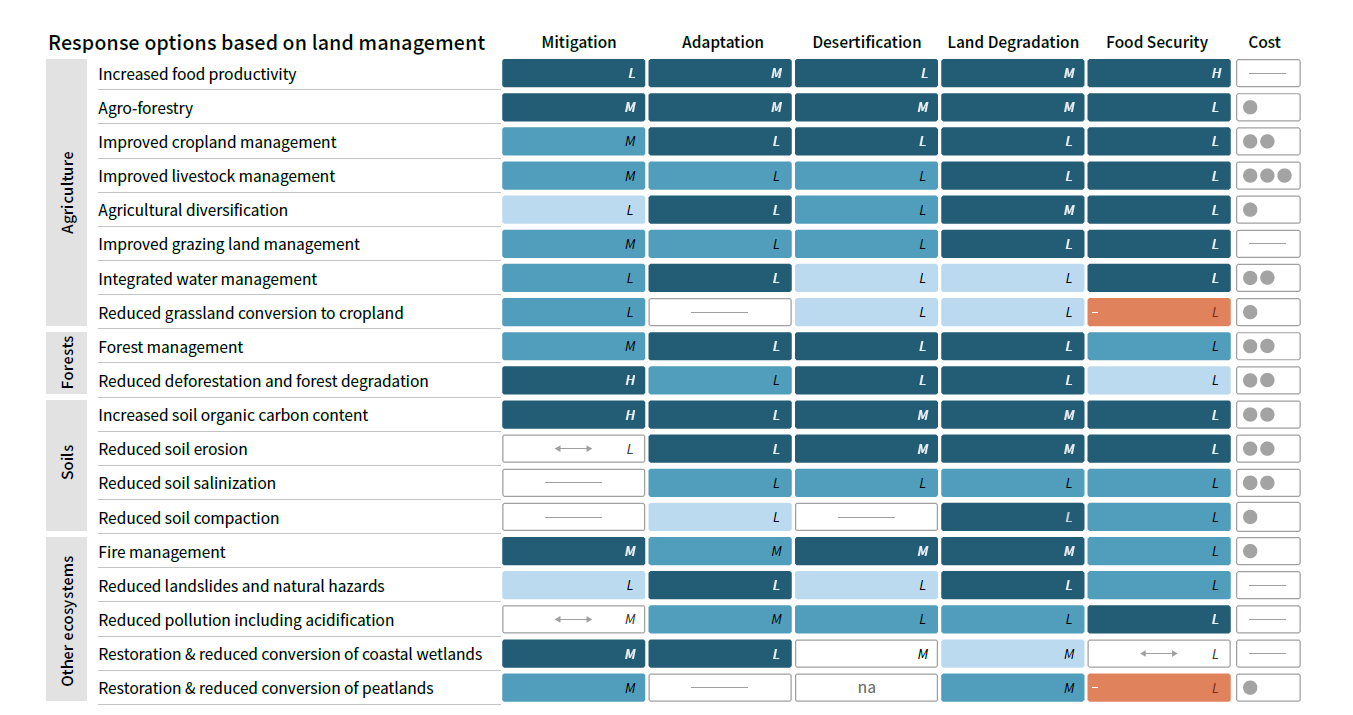This section assesses our current state of knowledge regarding the technical dimension of CCS as an option to achieve the college’s carbon neutrality goal. It starts with a brief overview of different types of carbon sequestration technology and past CCS practices. By discussing the components and features of industrialized CCS system, this section demonstrates why we chose the natural methods of CCS over large-scale industrialized practice at college level. Then it explores the main natural approaches to increase soil carbon storage, including agroforestry, organic farming and reforestation. After investigating the effectiveness and maturity of relevant technologies associated with these approaches, it narrows down to introducing our two phased reforestation plan starting at Metzger field. This technical report demonstrates the design elements, implementing timeline, material list, risks, relevant skills and knowledge gap of our alternative.

Figure 1. Classification of Carbon Sequestration Strategies (Lal, 2010)
Carbon sequestration is a process whereby CO2 is removed from the atmosphere and stored in the soil carbon pool. The carbon sequestration strategies, as figure 1 shows, are mainly divided into three branches. In this project, we compared the use of natural process and engineering techniques. The later one, engineered CCS, involves the use of technology to collect and concentrate the CO2 produced in industrial and energy-related sources, then transport it to and store at a suitable storage location for a long period of time. In the global context of stabilizing atmospheric CO2 concentration and the continuous dominance of fossil fuels in energy infrastructure, engineered CCS has been recognized as one of the proven mitigation options around the world because of the compatibility of CCS systems with current energy infrastructures (Metz, Davidson, & Coninck, 2005). By 2018, there were 43 large-scale CCS facilities globally with 21 under operation (Global CCS Institute, 2018).

Figure 2. Technology readiness level of carbon capture, storage and utilization technologies (Bui, Adjiman, & Bardow, 2018)
Although the industrialized CCS technologies have advanced at a fast pace in reaction to the urgency of mitigating climate change, its application at college level still faces many technical constraints. The current development progress of the technologies involved in different phases of CCS is unevenly distributed, as Figure 2 illustrates. The discrepancy in their maturity level would increase the rate of failure of the whole system. The key risks of implementing CCS system reside in the transportation and storage phases. Transporting CO2 from industrial site to a proper storage site needs construction of long pipelines. And long-term storage process requires injecting it into a rock formation below the earth’s surface or into the ocean at depths greater than 1,000m followed by physical trapping which might cause leakage and produce environmental hazards (Metz, Davidson, & Coninck, 2005). Additionally, the current CCS system is mostly applied to large point sources of CO2, like power plants and large industrial processes (Metz, Davidson, & Coninck, 2005) that do not exist at Lafayette College.
The carbon sequestration through natural approach therefore became the focus of our project which uses technologies that could increase the soil carbon storage through natural carbon cycling. The natural process, soil carbon sequestration, is primarily facilitated by photosynthesis of plants through which carbon is sequestered and stored in the form of SOC (Soil Organic Carbon). The current storage of SOC results from interactions among the dynamic ecological processes of photosynthesis, decomposition, and soil respiration (Ontl & Schulte, 2012). Human activities, such as land management and farming, have led to depleted SOC in the past decades. Nevertheless, we can now sequester carbon back into the soil through proper reforestation and farming technologies.
Enhancing soil carbon can yield significant co-benefits, including improved soil health, increased yields and water quality although the effect on carbon storage is limited as soil reaches its carbon saturation point. The Intergovernmental Panel on Climate Change (IPCC) Report on Climate Change and Land has discussed many organic farming techniques that enhances land carbon storage. Some of them are applying agroforestry, using plant varieties with deeper roots, adding organic materials to soil, and changing crop rotations. The potential for these strategies is location-specific, depending on the soil type, prior and current land management practices, environmental conditions and other factors (IPCC, 2019).
Other organic farming technologies that would be effective are non-till agriculture and cover cropping. Tillage is a widely used technique to dig and turn over soil, which release carbon into the atmosphere. Using organic no-till and using annual crops, such as winter rye, foxtail, field peas, and others, can help stabilize the soil and pull in carbon more efficiently (Dr. Nancy Waters). Cover cropping essentially requires for certain crops that can be planted temporarily, especially during the winter time, which helps with storing carbon more efficiently, reduces nitrogen leaching and decreases the possible risk of water erosion ( Rodale Institution, 2014).
Agroforestry consists of “traditional and modern land-use systems where trees are managed together with crops and/or animal production systems in agricultural settings” (Buttoud, 2013). And its overall goal is to establish a system “so that the final product is more valuable than in the absence of trees, while the risks of failed harvests and dependence on chemical inputs are reduced” (Buttoud, 2013). The techniques mostly remain the same, but the plant types and the area of land required to implement a successful agroforestry practice may vary. The selection of species plays a major role in this dynamic. Depending on the combinations created, the crops and trees might compete for necessary resources (Buttoud, 2013). And the most frequently used systems of agroforestry include alley cropping, forest farming, windbreaks, riparian forest buffers, silvopasture systems (USDA, 2019).
 Figure 3. Land management options to mitigate climate change (IPCC, 2019)
Figure 3. Land management options to mitigate climate change (IPCC, 2019)
Some researchers identified A/R (afforestation or reforestation) as the natural solution with the most potential to capture carbon from the atmosphere, potentially sequestering 307 Tg CO2e per year that is equivalent to 21% of current net annual emissions of the United States. (Fargione & Bassett, 2018). Reforestation is converting previously forested land back into forest while afforestation is planting forests on lands where they did not previously grow. Reforestation can have many benefits beyond removing carbon from the atmosphere, such as providing habitat, enhancing soil fertility, controlling floods, and improving air and water quality (IPCC, 2019). Most importantly, it is the most cost-effective carbon sequestration approach. Figure 3 shows various land management options, their potential effect on five ecological and social aspects with low to high confidence level, and their general cost (IPCC, 2019). It indicates that reducing deforestation has relatively high chances in mitigating climate change and moderate implementation cost. Therefore, we decide to investigate how reforestation can help Lafayette College to achieve its carbon neutrality goal.
Reforestation can produce many environmental and social benefits. By increasing base flow during drought and reducing flooding during rainfall events, reforestation reduces the local impact of extreme weather events on society and ecosystems. By stabilizing land against catastrophic movements and reducing run-offs, it could buffer against the negative consequences of climate change on vulnerable groups. By providing habitat to animals and other species, reforestation can enhance livelihood diversification and contribute to global biodiversity conservation. This larger biodiversity can increase the resilience of rural households to climate variations. (Locatelli, Catterall, & Imbach, 2015)
There often exists trade-offs between reforestation for mitigation and biological adaptation. Reforesting with the sole purpose of carbon storage for mitigation or timber production will often lead to negative impacts on biodiversity, water sources and livelihoods. The general guiding principle for reforestation is “climate-smart reforestation”, which is implementing an effective combination of approaches to achieve a balance among societal adaptation, climate mitigation, and ecological resilience. (Locatelli et al., 2015)
The key technical considerations for reforesting at college level are species variety, selection, site-specific conditions and forestry management. Tree mixes can store as much carbon as monocultures, and they are more resilient, have higher rates of water use (Kunert et al. 2012) and provide additional ecosystem benefits (Hulvey et al. 2013). However, tree mixes have a much higher planning and maintenance cost. In terms of species selection, native species are generally better than exotic species for seedling survival. Forestry management include the maintenance of the forest, timber harvesting and risk management of forest fire (USDA, 2019).
Our technical plan for reforesting on Lafayette College has two phases that consists of reforesting locations both on and off campus. At Metzgar field, there are a multitude of locations where Lafayette College could reforest. Two alternatives include the oak tree pathway and the department sponsored forest. At the sports complex there is a narrow road with walkways on either side that connects the parking lot to the various fields. This walkway is approximately 300 feet long. Lafayette College potentially could plant 24 total oak trees, 12 on each side of this walkway. Oak trees require a minimum of 25 feet of separation to allow the tree to properly grow. The second alternative is to have each of the schools 15 major departments sponsor and plant a tree each year. Each year each department can pick a native tree and will plant the tree at metzger field. If Lafayette College plants 15 trees each year for 15 years, they will have planted 225 trees by 2035. 225 trees evenly spaced will cover over 3 acres of land.
Planting oak trees are very similar to planting most trees. For this alternative, Lafayette College will purchase young oak trees because they are significantly cheaper and easier to plant than mature oak trees. The process of planting an oak tree is consists of digging a hole, placing the tree in the hole, back filling the hole, and lastly placing a thin layer of mulch around the tree. Each hole should be dug 2-3 times the width of the football, and at a depth so just the trunk flare is above ground. After digging and placing the tree, the original soil will be back filled in. Lastly, a 2-3 inches of mulch should be evenly spread out around the base of the tree. The mulch will help the tree receive the valuable nutrients and water in order to grow. This process will be repeated for all the trees that will be planted. The process of planting an individual tree will be the same for the department sponsored forest.
There are several constraints to reforestation. First to effectively reforest, the trees have to be native to Easton, Penslyvania. Many non-native trees are not be able to grow in the perennial weather. Also, non-native trees can have very bad implications to the native ecosystem. A second constraint is the current spotted lantern fly epidemic. Spotted lanternflies are an invasive species that can kill many of the native trees. The last constraint is the trees that should be planted are required to have a high carbon capture ability.
To read the Economic Context, click here.